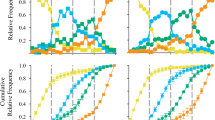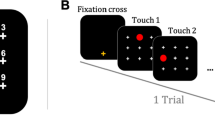Abstract
Two experiments investigated how brief pauses introduced into serial patterns as phrasing cues would affect pattern learning in rats. In Experiment 1, a 24-element pattern consisted of eight 3-element chunks, whereas a 20-element pattern consisted of four 5-element chunks. In both patterns, 3.0-s temporal pauses placed at chunk boundaries (synchronous phrasing cues) facilitated learning compared to no phrasing. Cues “out of sync” with pattern structure (asynchronous phrasing cues) facilitated learning for the 24-element pattern and retarded learning for the 20-element pattern. Evidence suggested that in the latter case, 3.0-s pauses served as “blank” trials that induced rats to “skip” to the next serial position in sequence. In Experiment 2, shorter 0.5-s pauses served as phrasing cues in the 20-element pattern of Experiment 1. Synchronous short cues facilitated learning, whereas asynchronous phrasing cues had no effect. Furthermore, removal of synchronous cues produced deficits in performance on formerly cued trials, whereas removal of asynchronous cues had no effect. The results of Experiment 2 support the notion that in both experiments phrasing cues served as discriminative cues and indirectly suggest that rats are concurrently sensitive to pattern element cues, extra-sequence cues (such as phrasing cues), and to the relative timing of sequential events.




Similar content being viewed by others
Notes
It should be noted that in both of the reports by Restle (1972) in humans and by Fountain et al. (1984) in rats, synchronous and asynchronous phrasing manipulations were termed “good” and “bad” phrasing, respectively. They were so named because of the “good” or “bad” correspondence between cues and formally defined pattern structure, not because they produced good or bad performance. We prefer the terms “synchronous” and “asynchronous” phrasing to “good” and “bad” phrasing because the former clearly refer to the positioning of phrasing cues relative to element structure.
References
Botvinick M, Plaut DC (2004) Doing without schema hierarchies: a recurrent connectionist approach to normal and impaired routine sequential action. Psychol Rev 111:395–429
Bower GH, Winzenz D (1969) Group structure, coding, and memory for serial digits. J Exp Psychol Monogr 80(Part 2):1–17
Burns RA, Dunkman JA Jr, Detloff SL (1999) Ordinal position in the serial learning of rats. Anim Learn Behav 27:272–279
Burns RA, Kinney BA, Criddle CR (2000) Position cues and reward memories as compatible components of serial learning. Learn Motiv 31:236–250
Capaldi EJ, Miller DJ (1988) Counting in rats: its functional significance and the independent cognitive processes that constitute it. J Exp Psychol Anim Behav Processes 14:3–17
Capaldi EJ, Miller RM (2004) Serial learning in rats: a test of three hypotheses. Learn Motiv 35:71–81
Capaldi EJ, Verry DR, Nawrocki TM, Miller DJ (1984) Serial learning, interitem associations, phrasing cues, interference, overshadowing, chunking, memory, and extinction. Anim Learn Behav 12:7–20
Capaldi EJ, Nawrocki TM, Miller DJ, Verry DR (1986) Grouping, chunking, memory, and learning. Q J Exp Psychol Comp Physiol Psychol 38B:53–80
Capaldi EJ, Birmingham KM, Miller RM (1999) Forming chunks in instrumental learning: the role of overshadowing. Anim Learn Behav 27:221–228
Chen S, Swartz KB, Terrace HS (1997) Knowledge of the ordinal position of list items in rhesus monkeys. Psychol Sci 8:80–86
Fountain SB (1990) Rule abstraction, item memory, and chunking in rat serial-pattern tracking. J Exp Psychol Anim Behav Processes 16:96–105
Fountain SB (2006) The structure of sequential behavior. In: Wasserman EA, Zentall TR (eds) Comparative cognition: experimental explorations of animal intelligence. Oxford University Press, Oxford, pp 439–458
Fountain SB, Annau Z (1984) Chunking, sorting, and rule-learning from serial patterns of brain-stimulation reward by rats. Anim Learn Behav 12:265–274
Fountain SB, Benson DM Jr (2006) Chunking, rule learning, and multiple item memory in rat interleaved serial pattern learning. Learn Motiv 37:95–112
Fountain SB, Rowan JD (1995) Coding of hierarchical versus linear pattern structure in rats and humans. J Exp Psychol Anim Behav Processes 21:187–202
Fountain SB, Rowan JD (1995) Sensitivity to violations of “run” and “trill” structures in rat serial-pattern learning. J Exp Psychol Anim Behav Processes 21:78–81
Fountain SB, Rowan JD (2000) Differential impairments of rat serial-pattern learning and retention induced by MK-801, an NMDA receptor antagonist. Psychobiology 28:32–44
Fountain SB, Henne DR, Hulse SH (1984) Phrasing cues and hierarchical organization in serial pattern learning by rats. J Exp Psychol Anim Behav Processes 10:30–45
Fountain SB, Krauchunas SM, Rowan JD (1999) Serial-pattern learning in mice: pattern structure and phrasing. Psychol Record 49:173–192
Fountain SB, Rowan JD, Benson DM Jr (1999) Rule learning in rats: serial tracking in interleaved patterns. Anim Cogn 2:41–54
Fountain SB, Benson AM, Wallace DG (2000) Number, but not rhythmicity, of temporal cues determines phrasing effects in rat serial-pattern learning. Learn Motiv 31:301–322
Fountain SB, Wallace DG, Rowan JD (2002) The organization of sequential behavior. In: Fountain SB, Bunsey M, Danks JH, McBeath MK (eds) Animal cognition and sequential behavior: behavioral, biological, and computational perspectives. Kluwer, Boston, pp 115–150
Fountain SB, Rowan JD, Carman HM (2006) Encoding structural ambiguity in rat serial pattern learning: the role of phrasing. Int J Comp Psychol (in press)
Harris EH, Washburn DA (2005) Macaques’ (Macaca mulatta) use of numerical cues in maze trials. Anim Cogn 8:190–199
Keele SW, Ivry R, Mayr U, Hazeltine E, Heuer H (2003) The cognitive and neural architecture of sequence representation. Psychol Rev 110:316–339
Leeuwenberg ELL (1969) Quantitative specification of information in sequential patterns. Psychol Rev 76:216–220
Marshuetz C (2005) Order information in working memory: an integrative review of evidence from brain and behavior. Psychol Bull 131:323–339
Miller GA (1956) The magical number seven, plus or minus two: some limits on our capacity for processing information. Psychol Rev 63:81–97
Palmer C, Pfordresher PQ (2003) Incremental planning in sequence production. Psychol Rev 110:683–712
Restle F (1970) Theory of serial pattern learning: structural trees. Psychol Rev 77:481–495
Restle F (1972) Serial patterns: the role of phrasing. J Exp Psychol 92:385–390
Roitblat HL, Pologe B, Scopatz RA (1983) The representation of items in serial position. Anim Learn Behav 11:489–498
Simon HA (1974) How big is a chunk? Science 183:482–488
Stempowski NK, Carman HM, Fountain SB (1999) Temporal phrasing and overshadowing in rat serial-pattern learning. Learn Motiv 30:74–100
Terrace HS (1987) Chunking by a pigeon in a serial learning task. Nature 325:149–151
Terrace HS (2005) The simultaneous chain: a new approach to serial learning. Trends Cogn Sci 9:202–210
Treichler FR, Van Tilburg D (2002) Premise-pair training for valid tests of serial list organization in macaques. Anim Cogn 5:97–105
Treichler FR, Raghanti MA, Van Tilburg DN (2003) Linking of serially ordered lists by macaque monkeys (Macaca mulatta): list position influences. J Exp Psychol Anim Behav Processes 29:211–221
Acknowledgments
This work was supported in part by the National Institute of Mental Health Grant MH48402. We thank Michael L. Nering and Andrew W. Proctor for assistance in conducting surgery and collecting data.
Author information
Authors and Affiliations
Corresponding author
Rights and permissions
About this article
Cite this article
Wallace, D.G., Rowan, J.D. & Fountain, S.B. Determinants of phrasing effects in rat serial pattern learning. Anim Cogn 11, 199–214 (2008). https://doi.org/10.1007/s10071-007-0110-7
Received:
Revised:
Accepted:
Published:
Issue Date:
DOI: https://doi.org/10.1007/s10071-007-0110-7




